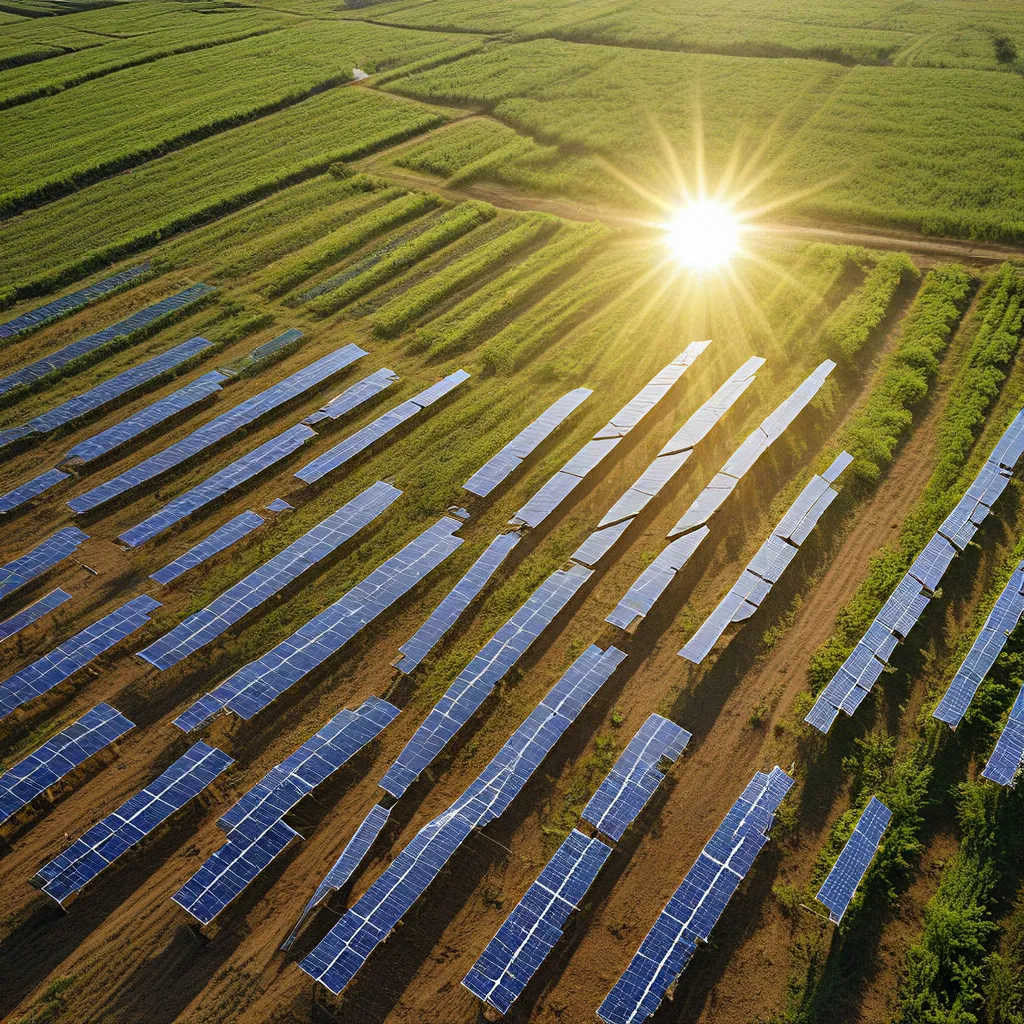
As I stand amidst the verdant fields, the gentle hum of solar panels blends seamlessly with the rustling leaves and buzzing insects. It’s a symphony of nature and technology, a harmonious dance that promises a future where renewable energy and agriculture coexist in perfect symbiosis. Welcome to the captivating world of agrivoltaics – where the sun’s power not only illuminates our homes but also nourishes the very land that sustains us.
Cultivating a Greener Future
Picture a landscape where solar arrays don’t just occupy barren plots, but where they coexist with thriving crops and grazing livestock. This is the essence of agrivoltaics, a revolutionary approach that is redefining the way we think about energy production and food security. By integrating photovoltaic systems into agricultural settings, we are unlocking a world of possibilities that were once deemed impossible.
Agrivoltaics, or AV as it’s often called, is a concept that has been around since the 1980s, yet its true potential has only recently been unleashed. The idea is simple: harness the sun’s energy to generate clean electricity while simultaneously preserving valuable farmland and boosting crop yields. It’s a win-win scenario, a testament to the ingenuity of human innovation.
Shedding Light on the Benefits
As I delve deeper into this captivating intersection, I can’t help but be amazed by the myriad of benefits that agrivoltaics offers. Let’s start with the most obvious one: energy production. By strategically placing solar panels above crops or pastures, we’re able to generate renewable electricity that can power our homes, businesses, and communities. But the magic doesn’t stop there.
The shading effect of the solar panels provides crops with much-needed protection from the scorching sun, ultimately improving their yields and resilience. Imagine delicate leafy greens thriving under the gentle embrace of solar technology, or hardy grains basking in the filtered light – it’s a symbiotic relationship that defies conventional wisdom.
But the benefits don’t end there. Agrivoltaic systems can also help conserve precious water resources, a critical consideration in an era of climate change and dwindling supplies. As plants transpire beneath the panels, the resulting cooling effect enhances the efficiency of the solar arrays, creating a virtuous cycle of energy and water conservation.
Overcoming Challenges
Of course, as with any revolutionary concept, agrivoltaics is not without its challenges. Maintaining these intricate systems requires a delicate balance, and factors like dust accumulation, bird threats, and chemical contamination must be carefully managed. But where there’s a will, there’s a way – and innovative solutions are emerging to tackle these obstacles head-on.
Imagine a future where solar panels are meticulously cleaned using biodegradable and solar-certified cleaning agents, ensuring optimal efficiency without compromising the surrounding environment. Or picture a landscape dotted with anti-soiling coatings that reduce the buildup of dust and debris, allowing the panels to operate at peak performance.
These cutting-edge advancements are not mere pipe dreams, but tangible realities that are shaping the future of agrivoltaics. By addressing the unique maintenance challenges, we’re paving the way for these hybrid systems to thrive, unlocking their full potential to power our world and feed our people.
A Tapestry of Possibilities
As I gaze across the fields, I’m struck by the sheer diversity of agrivoltaic applications. It’s not just about growing crops under solar panels; the possibilities are as varied as the landscapes themselves. Aquavoltaics, for instance, integrates solar energy production with aquaculture, harnessing the sun’s power to cultivate fish and other aquatic species. Silvopastoral systems, on the other hand, blend solar panels with grazing livestock, creating a harmonious ecosystem where energy, food, and fiber production coexist.
And the innovation doesn’t stop there. Crop-AgroPV systems are engineered to optimize the placement and orientation of solar panels to maximize both energy generation and crop yields. It’s a delicate dance, requiring a deep understanding of plant biology, solar technology, and environmental factors. But the potential rewards are immense, transforming once-barren plots into vibrant, multifunctional oases.
Cultivating a Brighter Future
As I stand here, surrounded by the tangible manifestation of renewable energy and sustainable agriculture, I can’t help but feel a sense of awe and optimism. This is not just about generating electricity or growing food; it’s about forging a path towards a future where our energy and food systems coexist in perfect harmony.
Agrivoltaics is empowering farmers, enhancing food security, and revolutionizing the way we think about the suns power. It’s a testament to the ingenuity of the human spirit, a rallying cry that showcases the transformative potential of renewable energy when combined with the age-old wisdom of agriculture.
So, let us embrace this solar-powered symbiosis, this tapestry of possibilities that holds the key to a more sustainable, nourished, and resilient world. Because when the sun’s rays illuminate not just our homes, but the very land that sustains us, we witness the birth of a future where energy and agriculture coexist in perfect harmony. And that’s a future worth fighting for.